Description
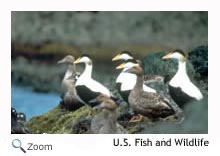 The common eider is a sea duck. It is the largest duck in the Northern Hemisphere. It is 25-27 inches in length with a wingspan of 41 inches. The male has a white back, neck, and chest. He has a black cap on his head with a green tinge on the back and sides of his head. His
legs, feet, and bill are a greenish yellow.
The female is a mottled cinnamon-brown with black bars. Her
legs, feet, and bill are greenish gray. Both the male and the female have a long bill and a long, sloping forehead. The common eider is a sea duck. It is the largest duck in the Northern Hemisphere. It is 25-27 inches in length with a wingspan of 41 inches. The male has a white back, neck, and chest. He has a black cap on his head with a green tinge on the back and sides of his head. His
legs, feet, and bill are a greenish yellow.
The female is a mottled cinnamon-brown with black bars. Her
legs, feet, and bill are greenish gray. Both the male and the female have a long bill and a long, sloping forehead.
Range 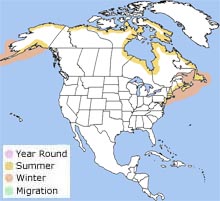 During breeding season, the common eider
is found across Alaska and Canada south to Massachusetts. In the winter, it is found along the Pacific Coast from Alaska south to Washington and along the Atlantic Coast from Canada south to New York. The common eider is also found in Europe and Asia. During breeding season, the common eider
is found across Alaska and Canada south to Massachusetts. In the winter, it is found along the Pacific Coast from Alaska south to Washington and along the Atlantic Coast from Canada south to New York. The common eider is also found in Europe and Asia.
Habitat
The common eider is found
along rocky coasts and coastal tundra.
Diet
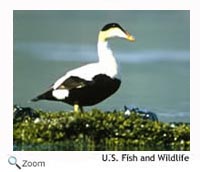 The common eider is a diving duck, and it eats mussels, clams, scallops, sea urchins, starfish, and crabs. Common eiders swallow their prey whole and then crush them with their gizzard! Common eiders feed in groups for up to 30 minutes at a time. After feeding, they rest, preen, and then feed again throughout the day. The common eider is a diving duck, and it eats mussels, clams, scallops, sea urchins, starfish, and crabs. Common eiders swallow their prey whole and then crush them with their gizzard! Common eiders feed in groups for up to 30 minutes at a time. After feeding, they rest, preen, and then feed again throughout the day.
| |
Life Cycle 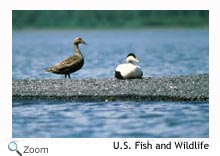 The male common eider courts the female by tossing his head, stretching out his neck, flapping his wings, and making a series of loud moaning calls. Pairs can form in the winter grounds or on the breeding grounds. The pair selects a nesting site in the grass. The male common eider courts the female by tossing his head, stretching out his neck, flapping his wings, and making a series of loud moaning calls. Pairs can form in the winter grounds or on the breeding grounds. The pair selects a nesting site in the grass.
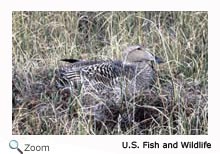 The female plucks down from her chest to line the nest. The female's coloring is good deceptive coloration and helps to camouflage her in the grass. She lays 2-8 eggs and incubates them for about 25 days. The male usually leaves once the female begins to incubate the eggs.
The ducklings fledge when they are about two months old. Young eider ducklings may gather in groups or crèches where they are cared for by non-breeding female eiders. Gathering in large groups helps protect the young eiders from predators. The female plucks down from her chest to line the nest. The female's coloring is good deceptive coloration and helps to camouflage her in the grass. She lays 2-8 eggs and incubates them for about 25 days. The male usually leaves once the female begins to incubate the eggs.
The ducklings fledge when they are about two months old. Young eider ducklings may gather in groups or crèches where they are cared for by non-breeding female eiders. Gathering in large groups helps protect the young eiders from predators.
Behavior
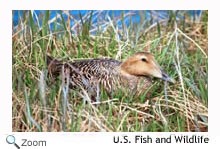 The down of the common eider is very soft and thick and is good insulation from cold ocean waters. Eider down is sometimes used to stuff pillows, sleeping bags, parkas, and quilts. It was once used much more extensively, but it has been replaced by synthetic fibers and goose down. The down of the common eider is very soft and thick and is good insulation from cold ocean waters. Eider down is sometimes used to stuff pillows, sleeping bags, parkas, and quilts. It was once used much more extensively, but it has been replaced by synthetic fibers and goose down.
|



 During breeding season, the common eider
is found across Alaska and Canada south to Massachusetts. In the winter, it is found along the Pacific Coast from Alaska south to Washington and along the Atlantic Coast from Canada south to New York. The common eider is also found in Europe and Asia.
During breeding season, the common eider
is found across Alaska and Canada south to Massachusetts. In the winter, it is found along the Pacific Coast from Alaska south to Washington and along the Atlantic Coast from Canada south to New York. The common eider is also found in Europe and Asia.



